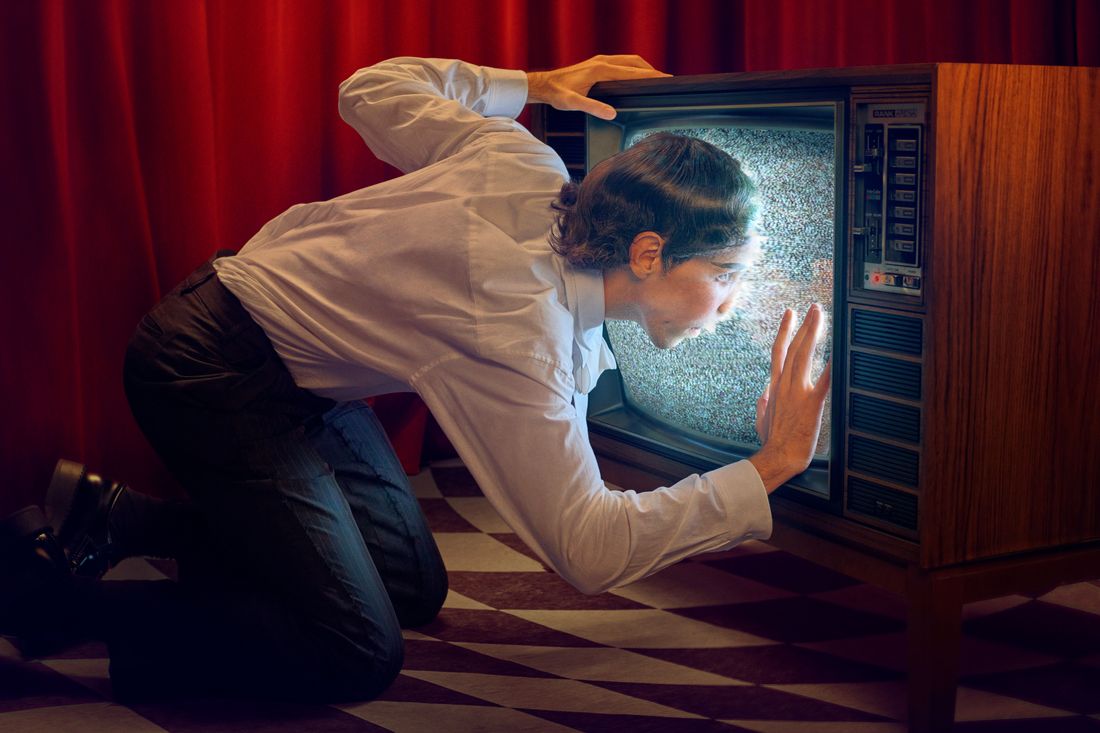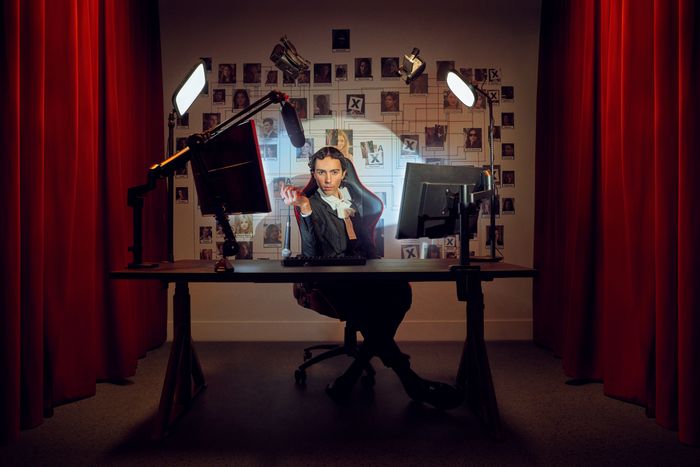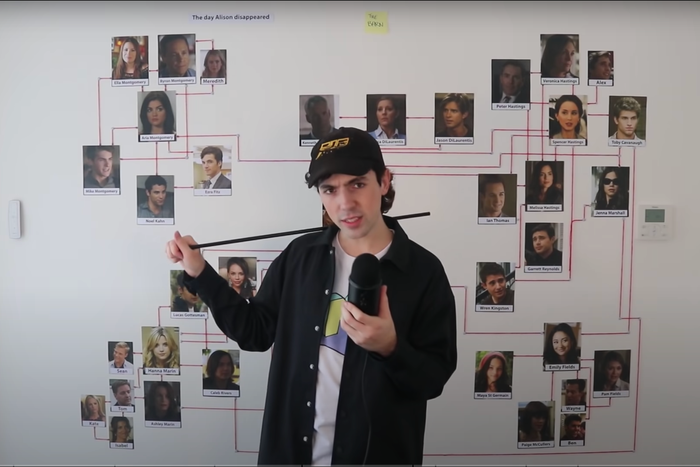
This article was featured in One Great Story, New York’s reading recommendation newsletter. Sign up here to get it nightly.
The reaction video has been a staple of YouTube for more than a decade. People react to songs they’ve never heard, video games they’ve never played, and even their own videos — usually old ones that fill them with embarrassment. Over roughly the past two years, a new form has flourished and become its own microgenre: watching other people watch TV. Many, many people are now discovering old shows through other people’s recaps, and for plenty of them, watching recaps has replaced watching the shows entirely. This alternative approach to television has YouTubers presenting their audiences with elaborate, meticulous autopsies of shows that once defined generations.
Every nook and frame, every plot hole, every questionable character decision and gag, and every delivery of an off-color line that could have made it to television only back then is dissected and debated. The videos are ambitious and exhaustive and often cover a series so closely, with such minute detail, that the recap’s major contribution is to elevate the original work itself. It is the natural evolution of the format, the next step in creating content for an audience that increasingly asks more from entertainment. And no one’s better at it than Australian YouTuber Michael Messineo.
Messineo is the creator, producer, editor, and star of the popular YouTube channel Mike’s Mic, and his videos are the prestige TV of the genre: formally experimental multi-episode narratives known for the obsessive level of commentary he brings. They’re the equivalent of television events, painstakingly created over many months of near radio silence, with fans drip-fed updates on each episode’s progress on Messineo’s other socials as well as the occasional one-off YouTube upload, like “The International Implications of Robots (2005).” The result when the video eventually goes live is a rolling boil of views and thousands of comments praising Messineo for his hyperspecific annotations or outright calling his work “literally the most culturally important event of 2023.”
When selecting which shows to focus on, Messineo says it’s vital that he is, or was, a fan. How else could you commit to that sort of enthusiastic interrogation? And how else could you convince an audience you’re the one to watch do it? The point of Mike’s Mic is to celebrate what Messineo calls a “golden era” in television history: that fractured period between 2006 and 2012, when iPhones were still considered luxuries and social media was pure, innocent, and fun — the time of shows like Pretty Little Liars, Glee, and Gossip Girl. “I’m not recapping shitty shows — these were huge,” he says. “These are not covering something with 1,000 weekly followers. Last time these shows were on TV, they had viewers in the millions.” They also tend to include some amount of nonsensical chaos, giving Messineo the perfect opportunity to step in and bring some order to it all by attempting to explain what transpired.
There is a structural arc to Messineo’s recaps, with the context to characters and story lines, as well as the rules and morals he uses as guiding rails, often laid out ahead of time — like choosing not to discuss the real-world drama surrounding Glee, for example. Something physical is also almost always involved. For Pretty Little Liars, he mapped relationships between characters and the plot using colored strings, creating a manic, private-investigator-in-the-basement mess of yarn over seven seasons and 160 episodes. For Gossip Girl, he gave each season its own multiple-hour deep dive after his followers complained about not getting enough detail; he analyzed the episodes through the lens of which mobile phones were in style (in the pilot of Gossip Girl, for example, protagonist Blair Waldorf uses a T-Mobile Sidekick 3 Limited Edition). For his Glee series, in “An appropriately unhinged recap of Glee (part 1),” he covered one whiteboard corner to corner with little pieces of paper that meticulously noted “the greatest and worst hits” for every character. “I will not be discussing every single plot detail,” he says. “Because I don’t think it will add anything to your experience.”
“And also, the lack of continuity between plotlines would make you want to rip your face off,” he adds.
The appeal of a YouTube recap hinges on how entertaining the personality at the center is, and Messineo is almost hypnotic. To watch him in his videos is to watch something uniquely 2020s: the combination of a witty character, endlessly affected by YouTuber and influencer culture, with a vocabulary cluttered with meme-y tics; callbacks to Charli XCX’s 2014 album, Sucker; Lady Gaga quotes; occasional dialed-up British accents; and, for the repeat and loyal viewers, self-referential nods to his own channel’s deep cuts. When he begins his Glee breakdown wearing a bright red Adidas tracksuit — a calling card of Jane Lynch’s snarky cheerleader coach, Sue Sylvester — it makes sense. But an hour later, when Messineo dives into season two, he dons a pair of drooping Italian sunglasses — this time not a reference to Glee but to a 2011 trip to the country that he discussed in an episode of his podcast, Jumping in an Elevator, before lengthy recaps became his thing. “Some of you understand,” he says, “and those of you that don’t: time to do some background reading.”
The 27-year-old grew up in Mandurah, Western Australia, about an hour from the state’s capital, Perth, and graduated from university with a master’s in engineering. His first postgrad job was, as he puts it, “hard-core programming” for a consultancy in Melbourne, where he now lives; it paid him little (for that field, anyway) and worked him to the bone. He spent his free time playing around on YouTube and launched his channel in 2015. He would work on videos for hours alongside his day job, often late into the evening (what he calls “feral behavior”). He has mostly wiped his early videos (“cringe”), which consisted of short clips and lists (“7 Things to Do When Bored” was his first-ever upload), and has experimented with a Rolodex of classic YouTube formats: real-estate reviews, messy tweets, meme reviews, tours of his apartment. His first hit was a 2019 video on Bigg Boss, India’s answer to Big Brother, featuring Messineo tightly breaking down a single scene of conflict between two characters fighting in typical Big Brother fashion (someone isn’t cleaning enough; someone doesn’t like being asked to clean). “Those videos blew up in India,” he says. “For a while there, India was my biggest demographic.”
He decided to try out longform video with a three-part analysis of Pretty Little Liars that accelerated him to another level of microfame. The first video, premiered in November 2021, now has 6.5 million views. By the time the entire thing finished, two months later, screenshots of Messineo standing in front of his spiderweb of string, pointing at the characters, had spread across Tumblr. He was being written about in The Guardian, Vulture, and The Daily Beast as part of a “takeover” of YouTube and a phenomenon that was “better than TV.”
Messineo says he was inspired to try something new by the work of Jenny
Nicholson, a YouTuber who, in early 2021, published a two-and-a-half-hour breakdown of The Vampire Diaries. Producing his first Pretty Little Liars recap was “so stressful,” he remembers, because of the all-consuming process. The scripts for each of his videos sometimes stretch to over 30 pages; each page takes him about 25 to 30 minutes to record. Then comes more than 15 hours of editing, and none of this even takes into account actually watching the shows — which he says he does three times for each season of every series he focuses on. “With YouTube, if you’re not uploading,” he says, “you’re making money on what you have already done, which could fall off, or spike, at any second.”
And money is obviously important: Messineo quit his day job in late 2020. His main YouTube channel and his podcast channel (plus its Patreon) are now his only forms of income — revenue he regularly mentions YouTube takes 45 percent of (excluding money from his patrons). “I make the content on their platform, and we both make money off it,” he says. “I do think their cut is too high, but I wouldn’t have a job if they didn’t give me the platform.” The longform approach tends to pay off for him, though he won’t disclose how much — his videos have been successful because they have a long tail, consistently tallying millions of viewers over many months. Since his first extensive recap, Messineo’s real-life fame has grown too. For the launch of a new Pretty Little Liars series, Original Sin, HBO Max flew him to the U.S. to tour sets from the first series and interview the new cast. At home, he is regularly recognized by fans, but his fans aren’t just teenagers or TV buffs: Charli XCX follows him on TikTok, MUNA met up with him to parody the “naur” meme, and in early January, Rina Sawayama asked him to introduce her onstage on the Melbourne leg of her Australia tour. Meanwhile, he’s working on movie scripts — a series of three heist films, one set in a casino, one a “corporate heist,” and one involving time travel — that he says have become his ultimate goal, beyond keeping his YouTube channel rolling forever.
Messineo’s newest opus, launched June 23 and already approaching 1 million views, focuses on Lost, the six-season, 121-episode series about a plane crash but actually maybe about something more philosophical, which finished airing just as the 2010s began. His video covering season one features a physical blackboard covered with headshots of major characters and whose concept, he teases, is “a little bit genius” and will only make sense, maybe, if you watch until the end. “Imagine being a kid who loves numbers and patterns and mystery and then Lost starts? It was the show for me,” he says. “On TikTok, I’ll mention I’m doing Lost, and they’ll just be like: ‘What’s that?’ So I have to talk about it.” He adds, “Even if the video gets 10,000 views, at least I got to talk about it once.”



